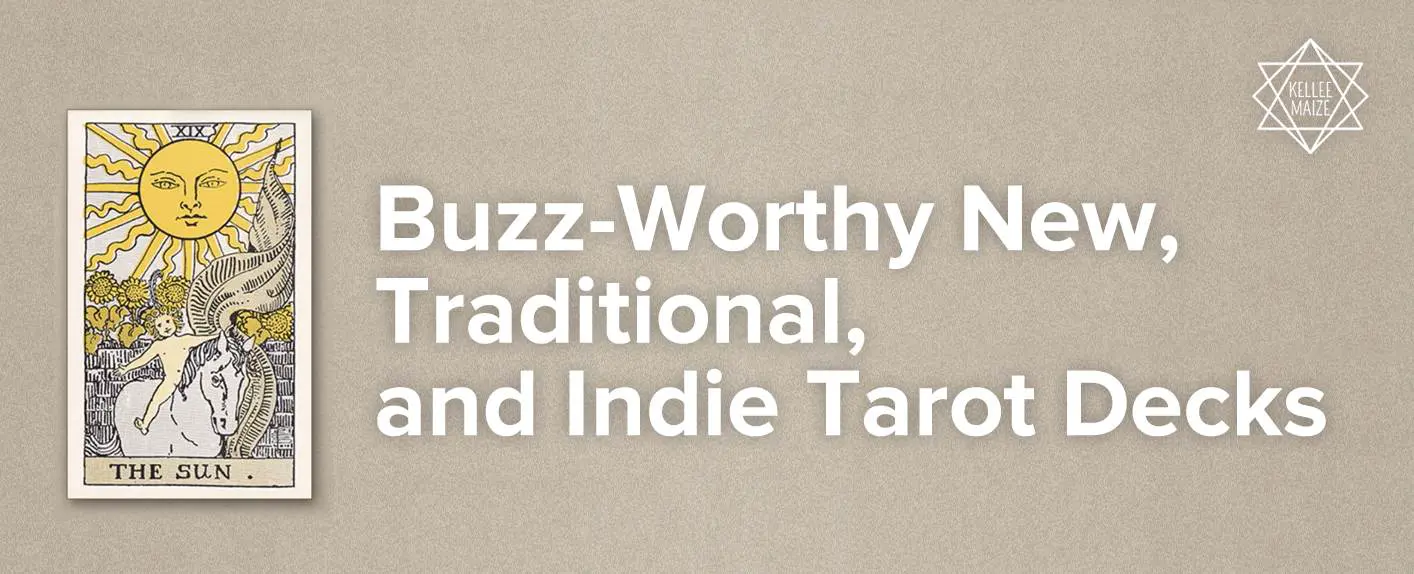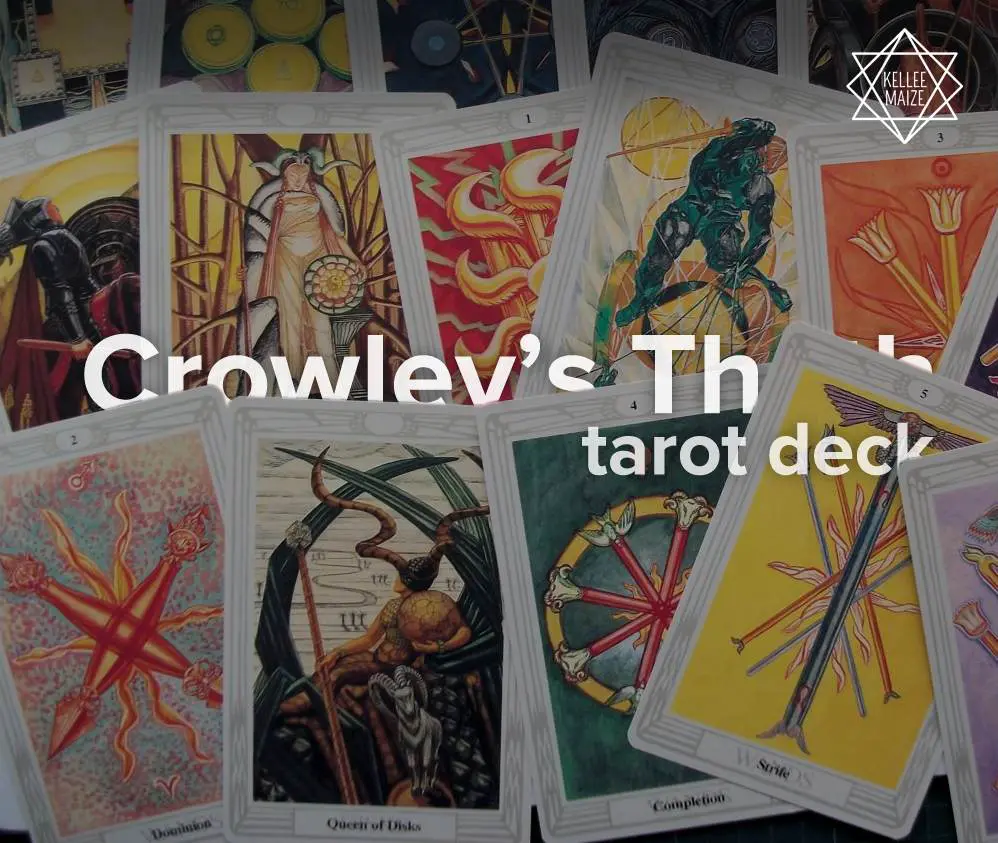
This history of tarot is full of decks with stunning artwork and designs. Choosing a tarot deck to work with can be the most frustrating and exciting thing for both newbies and professionals. There are so many choices! How do you navigate the search for that perfect deck that suits your needs and feels “just right?” We’ve compiled a list of our favorite decks, plus some extras:
There are two schools of thought on how the tarot deck should wind up in your hands.
The first group believes that your first deck should be a gift-- this is a very traditional view. The idea is like saying by Lao Tzu: “When the master is ready, the student will appear.”
The second group is essentially a reaction against this belief: choose your own deck. There’s some dissent over whether you’ll “know it when you see it” or if you can “learn to work with it.”
Either way, if you decide to choose your tarot deck for yourself, play Marie Kondo and ask yourself if it “sparks joy.” Do you love the illustrations? Do you connect with the deck’s theme? When you touch it and shuffle the cards, do you like the energy?
As a final note, everyone should consider the guidebook as well. Sometimes tarot decks do not include a guidebook, leaving the reader to decide what each card means. While this can be a very useful development tool, it can overwhelm a newcomer. Even professionals need to consult guidebooks sometimes, just in case they miss something or to get ideas for new tarot spreads.
Well-written guidebooks with simple layouts and tarot spread suggestions are worth their weight in gold!

Tradition is not something to be set aside easily. Tarot reading and the handling of the tarot deck has a lot of tradition behind it.
Most tarot decks consist of 78 cards: 22 Major Arcana card, four suites of 14 Minor Arcana cards, and four suites of 4 corresponding Court Cards. The Major Arcana are based on archetypes seen in dreams, literature, religion, etc. The Minor Arcana and their corresponding Court Cards relate to the tarot deck’s beginnings as playing cards. Each suite is based on an element-- earth, air, fire, water-- and rules over specific areas of life. The Court Cards represent actual people or their roles.
Your tarot deck’s guidebook should explain in detail each card’s meaning according to the theme of that deck.
Let’s take a closer look at the two tarot decks upon which most modern decks are based: Smith-Waite (sometimes called Rider-Waite) and Thoth.
It’s an oldie but a goodie. This deck was created to specifically use tarot cards as a divination tool for the masses-- it as the first to make reading tarot cards accessible to the layman. It was also the first to be published with a guidebook: The Key to the Tarot, by Arthur Waite. Illustrated by Pamela Coleman Smith, it wasn’t published with her name on it-- they used the publisher’s name instead. Hence, some practitioners called it the Rider-Waite and some the Smith-Waite deck.
Either way, it generally remains the top-selling deck on Amazon and in any bookstore. The images--whether you buy the reproductions or a deck illustrated by a modern artist-- are full of specific symbolism and have specific meanings. When the tarot cards are laid out in a spread, their upright or reversed (upside-down) meanings are read-- as well as the relationship between the cards’ positions.
The key to learning this tarot deck is as traditional as the idea of divination itself: memorization.
It is also worth noting that the Rider/Waite-Smith tarot deck is considered public domain as of 2012. Several printable versions--both black & white and color-- are available for free on the internet.

This deck was produced almost at the same time as the Rider/Smith-Waite deck. Created by Aleister Crowley it is infused with Kabbalistic and astrological imagery. The Thoth deck includes the same types of cards as its Golden Dawn counterpart. However, Crowley re-named and re-ordered them in comparison with previous tarot decks.
The Thoth deck is not generally recommended for new “cardslingers,” since it was intended for a student dedicated to a lifetime of stringent occult education. The guidebook contains a recommended reading list to familiarize the student with the meanings contained in each card.
Thoth tarot cards also take longer to interpret in a spread. The process involves determining the Elemental Dignity of the cards, before whether the card is upright or reversed is considered.
Crowley employed Lady Frieda Harris to illustrate his deck. She took instructions from him directly, and produced gorgeously lush illustrations. The Thoth tarot deck was originally designed to be more traditional-- like the Smith/Rider-Waite deck-- but Harris encouraged Crowley to include more of his original occult ideas. The two were very close friends. Harris even sketched him on his deathbed and paid for nurses to look after him. Unlike Smith, Harris was acknowledged for her part in the Toth tarot deck creation-- possibly because she was more socially connected and elite than Crowley or Smith.
Prior to 1996, the Thoth decks were public domain. Currently, the Thoth tarot deck is under a copyright battle between U.S. Games and Ordo Temli Orientis.

Every bookseller has a list of their own best-selling tarot decks that differ slightly from one to the other. All of them include the Smith/Rider-Waite and Thoth decks. Those decks-- and the way that they are structured-- inspired new decks. Here’s a list of some new best-selling tarot decks that appeal to both new and experienced cardslingers alike.
This deck was created by Kim Krans for her company The Wild Unknown in 2007. The deck’s illustrations are unique-- many are black & white but there are splashes of bright color throughout. The Court Cards are depicted as animals: swans, snakes, owls, and deer for Cups, Wands, Swords, and Pentacles.
The readings from this deck are honest and straightforward-- very easy to interpret in both simple and complex tarot card spreads.
The guidebook’s advice is solid and covers topics not often addressed. It is very specific about leaving the reading of reversed cards up to the reader. Krans also includes a brief section on asking questions and a message to the reader to encourage them to read their own cards.

The Wildwood Tarot deck was created by Mark Ryan and John Matthews and illustrated by Will Worthington in 2011. It’s based on another tarot deck that the two collaborated on in 1996-- The Greenwood Tarot-- which has reached cult collector status (Amazon recently listed it for around $1000 for a used deck.)
The Wildwood Tarot combines pre-Celtic mythology and shamanism for a tarot system that’s gorgeously illustrated and rich with symbolism. However, the cards are extremely easy to read because their essential meanings are included on the tarot cards themselves. Novice tarot card readers will definitely appreciate that extra touch.
Experience tarot card readers and newcomers alike will find the guidebook engaging and full of information. Each card is broken down into a description, meaning, and reading points section. Unique tarot card spreads are included in the back of the book.
There is also a companion workbook-- sold separately-- called Wild Magic: The Wildwood Tarot Workbook. Designed to further develop the reader’s relationship with The Wildwood Tarot cards, it also contains the author’s insights.

Written and illustrated by Ravynne Phelan, the Dreams of Gaia Tarot deck is inspired by traditional tarot decks but adds bold new archetypes and restructures the meanings of the cards.
Phelan’s Dreams of Gaia updates the meanings of the tarot cards for modern living. With an emphasis on healing and understanding the self, this deck has a distinctly gentle and comforting energy.
This deck’s re-structuring of the traditional tarot deck place is squarely in the intermediate level of learning to read tarot cards. The cards illustrations are vibrantly colored and creative.
Phelan’s guidebook to the Dreams of Gaia Tarot is very detailed. It includes not just keywords for remembering card meanings-- it also includes information on how the card applies to the past, present and future. Like Kim Krans, Phelan also includes a section on how to ask proper questions to get the most out of readings

Indie tarot decks are the cool new chicks on the block. They’re designed by small businesses and artists who do it for the love of tarot and art. Influencers like Gala Darling often prefer indie decks in an effort to not only support the artists and small businesses-- but also because indie tarot decks often offer illustrations you will not see in popular suppliers.
Many of these indie tarot decks are available on Etsy shops, but many are also available on personal websites, Instagram, and Pinterest.
Freyja's Daughter has several indie tarot decks to offer. All of the decks were created from very personal issues. The Blood, Bread & Roses tarot deck offers richly detailed cards inspired by struggles with addiction and mental illness. The Vintage Erotic deck offers playful digital collages based on vintage photographs (this deck does contain nudity).

Artist and Instagrammer Denielle Noel has created two tarot decks that are worth checking out: the Moonchild Tarot and the Starchild Tarot decks. Her illustrations are heavily informed by her travels-- the Startchild deck was inspired by Egypt-- and offer soft color palettes and feminine forms. Both decks encourage self-exploration and develop intuition.

Social media darling Ethony also serves up a dose of female empowerment with the Bad Bitches Tarot deck. The tagline reads: “Where spirituality meets sass.” That description of this indie tarot deck is accurate! The illustrations are simple images of women doing powerful things. The other concept that this indie tarot deck addresses that many mainstream ones don’t is diversity-- these tarot deck ladies come in all shapes and colors. Click on the link above and scroll down-- you can get a free one-card reading online!

This is just a sample of some of our current favorite tarot decks. Let us know yours in the comments, and be sure to tag us on social media if you buy any of these! We’d love to know your thoughts!